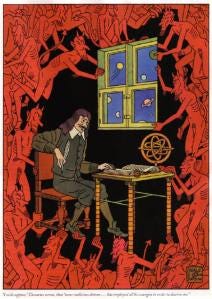Descartes Cogito, a quick explanation
Descartes's "Cogito, ergo sum" is one of if not the most famous one-liners in philosophy. Descarte’s main goal in his Meditations on First Philosophy was to arrive at a form of ‘‘perfect knowledge’’ or knowledge that can be held with complete certainty.
Descarte’s epistemology follows an internalist mode of justification or roughly the idea that the justifying factors of knowledge must be accessible to the knower’s conscious awareness. Descarte develops this idea by introducing what he called the Demon which systematically cast doubts on our external and internal experiences. The Evil Demon uses his great powers to create an illusion, the sky you see above you and the grass under you are simply perceptual illusions the Demon has manufactured. Our knowledge of the existence of an external world is uncertain, even our thoughts and emotions can be cast into doubt in virtue of this Evil Demon.
This thought experiment in combination with Descartes's search for perfect knowledge led to the utterance “Cogito, ergo sum”, or “I think therefore I am”. The only thing that is ever certain is that you exist. No matter how your experiences are twisted by the Demon you can never doubt that you experience!
This conclusion however leads to a metaphysical question, what exactly is the I that experiences? Descartes would point toward the existence of a nonphysical mind or soul that takes the place as ‘‘you’’, but Hume abjects and state that the self may just be a stream of present experiences failing to point at any underlying entity.



